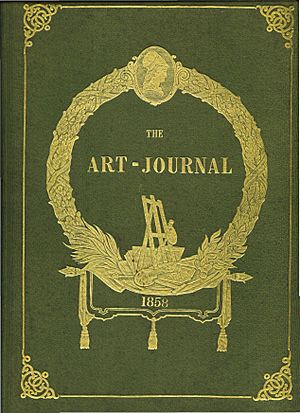The Art Journal facts for kids

Cover of a bound volume of The Art Journal from 1858
|
|
| Categories | Victorian art |
|---|---|
| Frequency | Monthly |
| Publisher | Hodgson & Graves; Samuel Carter Hall; George Virtue; J. S. Virtue |
| First issue | 15 February 1839 |
| Final issue | 1912 |
| Country | United Kingdom |
| Based in | London |
| OCLC | 1514293 |
The Art Journal was a very important British magazine about art in the 1800s. It started in 1839 and was first called Art Union Monthly Journal. The first issue had 750 copies and came out on February 15, 1839. It was published in London, England, but people all over the world read it.
Contents
The Story of The Art Journal
How the Magazine Started
A company called Hodgson & Graves started Art Union Monthly Journal. They hired Samuel Carter Hall to be the editor. He was helped by James Dafforne. Soon, Samuel Carter Hall owned most of the magazine. But he found it hard to make money from it by himself.
In 1848, a publisher from London named George Virtue bought a part of the business. Hall stayed on as the editor. They then changed the magazine's name to The Art Journal in 1849.
Growing Popularity and Challenges
In 1851, there was a big event called the "Great Exhibition". The Art Journal showed off 150 pictures from the private art collections of Queen Victoria and Prince Albert. Even though this was very popular, the magazine still wasn't making money.
Because of this, Hall had to sell his share of the journal to George Virtue. But Hall still stayed on as the editor. Finally, in 1852, the magazine started to make a profit!
Fighting for Honest Art
As editor, Samuel Carter Hall worked to show how much money was being made from importing old artworks. He also showed how some paintings were being made in England to look like old, famous ones. The Art Journal became known for being honest about fine arts. It spoke out against fake or wrongly labeled "Old Master" paintings. These were artworks supposedly by famous artists like Raphael and Titian. This honesty made it harder for people to sell fake art.
Art Groups and New Ideas
In its early days, the magazine strongly supported artists from a group called The Clique. After 1850, it started to disagree with a new art group called the Pre-Raphaelite Brotherhood (PRB). Hall thought the PRB was going backwards in art. The magazine published articles that criticized the PRB and its supporter, John Ruskin.
The End of an Era
Samuel Carter Hall retired in 1880. After he left, the magazine changed its views. It also faced strong competition from another magazine called Magazine of Art. Public taste in art was also changing, with new styles like Impressionism becoming popular.
Sadly, neither magazine lasted. The Magazine of Art stopped publishing in 1904. The Art Journal stopped in 1912. An American version of The Art Journal was published in New York from 1881 to 1887.
The magazine was sometimes called London Art Journal or Art-Journal.
Who Were the Editors?
| Editor's name | Years |
|---|---|
| Samuel Carter Hall | 1839–1880 |
| Marcus Bourne Huish | 1881–1892 |
| David Croal Thomson | 1892–1902 |
Important Writers and Artists
Many talented people wrote for The Art Journal. Some of the most famous writers included Ralph Nicholson Wornum, Thomas Wright, Frederick William Fairholt, Edward Lewes Cutts, and Llewellynn Jewitt. Richard Austin Artlett created many engraved pictures of sculptures for the magazine.

